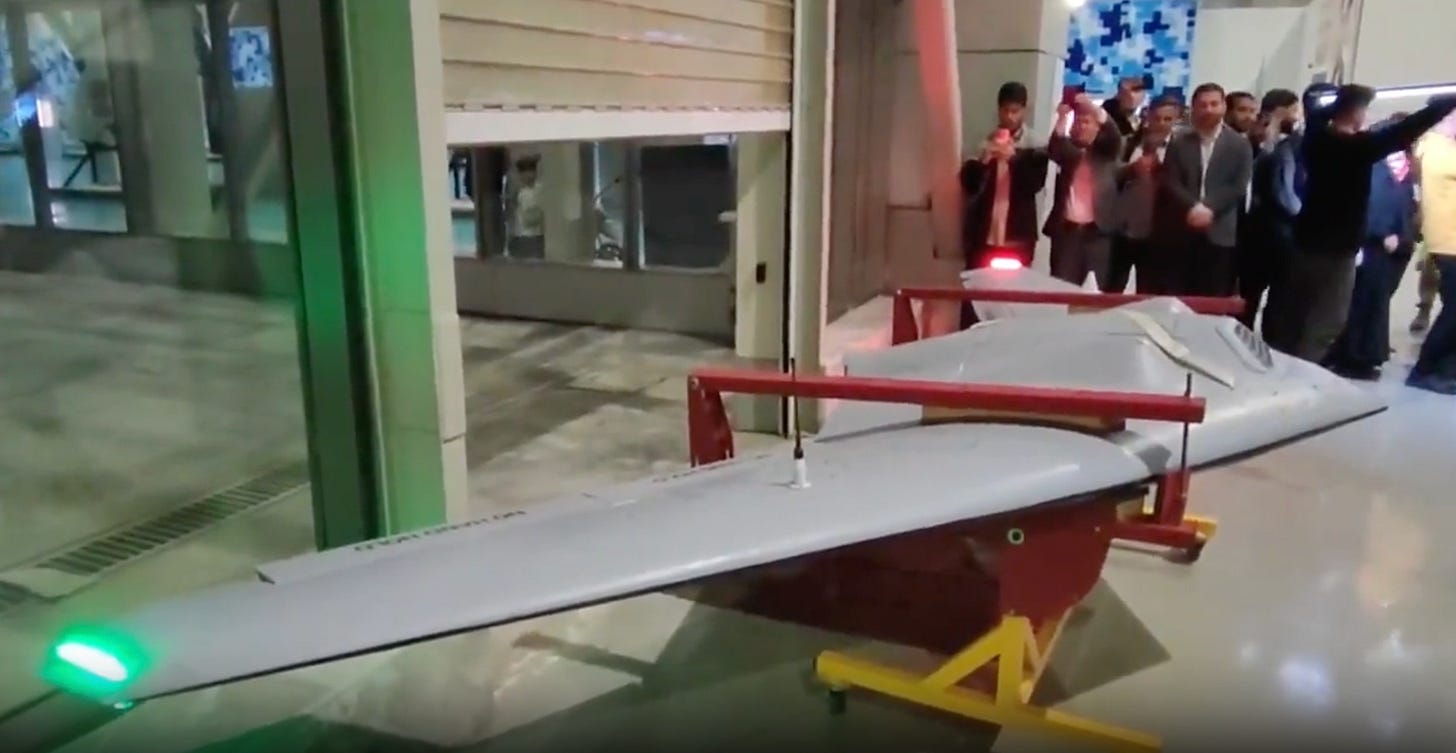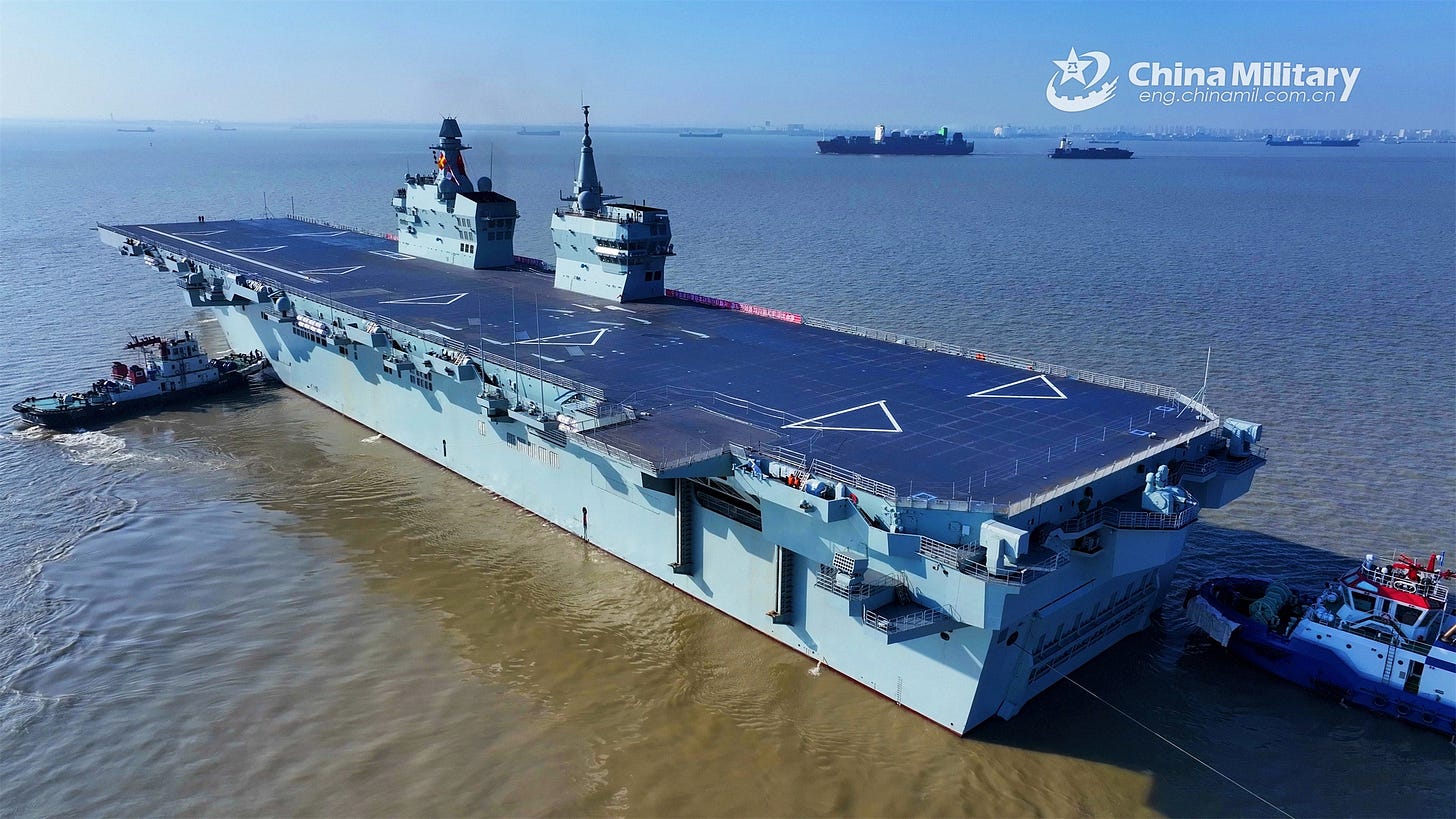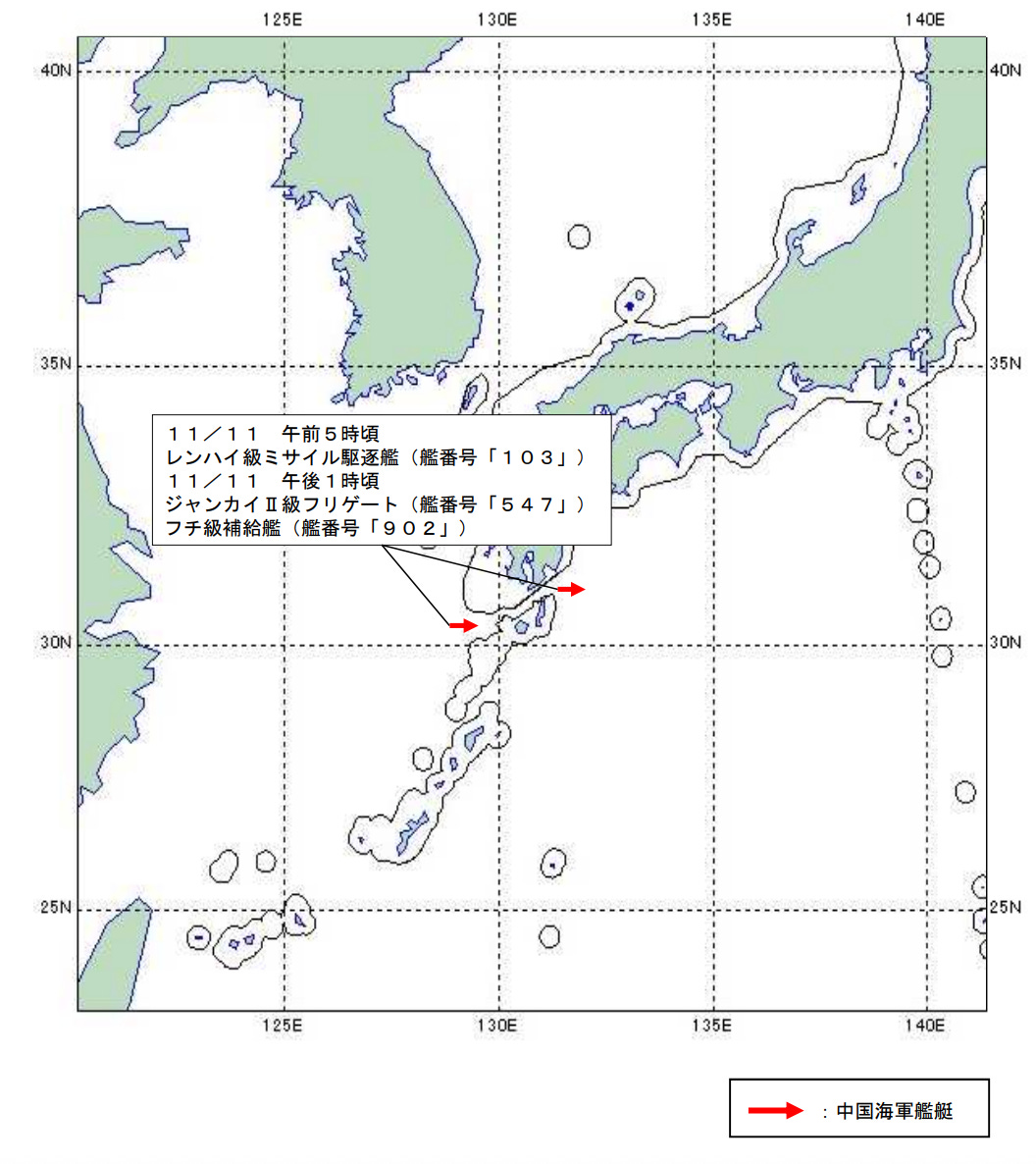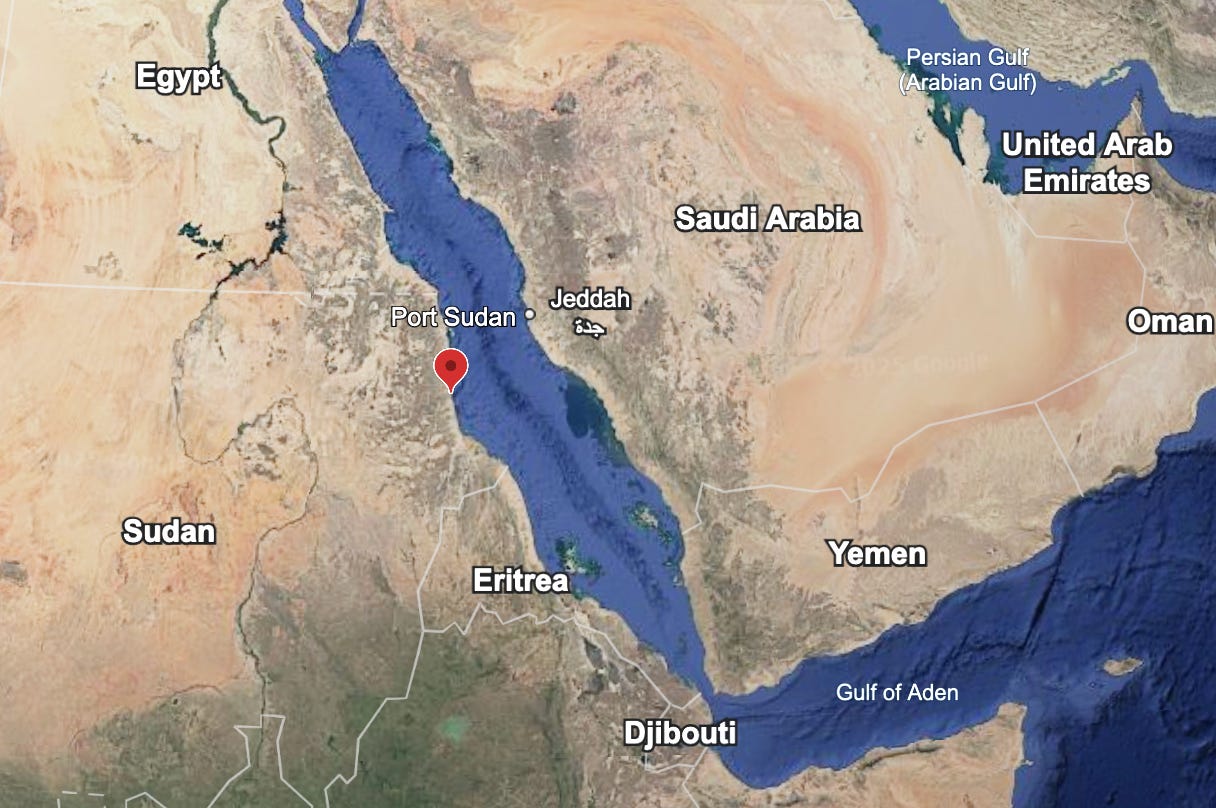Weekly Significant Activity Report - November 15, 2025
This week’s analysis highlights some of the most significant geopolitical developments involving America’s adversaries—China, Russia, Iran, and North Korea—between November 8 - November 15, 2025.
Summary:
Ukraine’s Defense Intelligence reported that Russia aims to produce 120,000 glide bombs this year, including hundreds of new bombs with ranges of over 200km. The rapid development and improvement of these weapons has been facilitated by Chinese technology.
Russia has suspended construction on its Red Sea naval base in Sudan amid intensifying civil war, marking yet another strategic setback in Africa where Moscow’s power appeared to be growing.
New developments in Russian, Chinese, and Iranian drones were announced.
The People’s Liberation Army Navy began sea trials for the Sichuan, the first of its new Type 076 amphibious assault ships and the largest amphibious assault ship in the world.
China reacted with unusual fury to recent statements by Japan’s new government that suggested Tokyo would defend Taiwan from blockade and invasion and would consider developing nuclear submarines.
China issued two arrest warrants for pro-independence Taiwanese social media influencers. It is the latest incident in which Beijing has attempted to use the international legal system to repress opponents of the Chinese Communist Party from Hong Kong and Taiwan.
Tehran officially began water rationing to combat its worsening water crisis. Some current and former Iranian officials worry that government intervention has come too little too late to avert disaster.
The Iranian Revolutionary Guard Corps Navy seized a Greek-owned, Marshall Islands flagged oil tanker near the Strait of Hormuz in what appears to be an attempt to crackdown on oil smuggling.
North Korea will reportedly send 12,000 laborers to Russia’s Alabuga Special Economic Zone by the end of the year to help the Russian military increase its production of Shahed-type drones.
New reports suggest Kim Jong-un is cementing changes to national ideology that abandon the reunification policy cultivated under his father and grandfather, in favor of permanent division of the Korean peninsula and enduring rivalry with the South.
1. RUSSIA MASSIVELY SCALING PRODUCTION OF GLIDE BOMBS
In a November 14 interview with Reuters, Deputy Chief of Ukraine’s Defense Intelligence (HUR), Major General Vadym Skibitsky, stated that Russia has dramatically scaled production of glide bombs and is projected to produce as many as 120,000 of the weapons this year. Major General Skibitsky also announced Russia’s development of newer, longer-range glide bombs. He stated that 500 bombs capable of striking targets 200km away will be produced by year’s end, and that Russia is researching models with ranges extending to 400km.
Takeaways:
The improvements to the range of Russia’s glide bombs have come with Chinese assistance. Remains of a UMPB-5 guided glide bomb recovered in Poltava in October contained SW800Pro-Y turbo-prop engines, manufactured by Chinese company Swiwin. Engines produced by Swiwin have also appeared this year in Russian Shahed-type drones and S8000 “Banderol” cruise missiles.
The Russian military has increasingly relied on glide bombs to strike targets from further away due to the potency of Ukraine’s air defenses. Russia has used the weapons to demolish Ukrainian cities in the Donbas which have posed serious obstacles to its advances. The increasing range and accuracy of the glide bombs allow them to serve as a substitute for more complex and expensive cruise missiles.
While Ukraine can intercept the glide bombs and divert them with jamming, the sheer numbers of the weapons that Russia is producing present a serious obstacle for its air defenses. A more sustainable Ukrainian strategy for countering these strikes involves further developing Ukraine’s own long-range strike capabilities to target Russian airbases and aircraft. Degrading Russia’s broader aviation assets, and airbases close to Ukraine would force it to operate with fewer deployable aircraft, flying longer missions, and utilizing a smaller number of ultra-long-range glide bombs.
2. RUSSIA MAY LOSE STRATEGIC FOOTHOLD IN AFRICA DUE TO SUDANESE CIVIL WAR
In an interview with RIA Novosti on November 14, Russian Ambassador to the Republic of Sudan, Andrei Chernovol, stated that the planned construction of a Russian naval logistics base at Port Sudan has been suspended indefinitely due to the intensifying Sudanese civil war.
An agreement to build a Russian naval base at Port Sudan had first been discussed in 2019 and officially agreed to in 2020. However, civil war and political instability in the country (including the ouster of former President Omar al-Bashir who initially negotiated the deal) delayed its development until February 2025, when Russia and Sudan reached a new 30-year agreement.
The naval base was projected to host up to 3,000 Russian service members and provide logistical support for Russian war ships including nuclear submarines.
Takeaways:
The Port Sudan base was seen as a more secure alternative to the Tartus naval base in Syria for projecting Russian naval power into the Middle East and North Africa, especially after the toppling of the Assad regime in December 2024. However, the intensification of the conflict in 2025, with Rapid Support Forces (RSF) rebels launching drone attacks on Port Sudan, has increasingly cast doubt on the long-term viability of the base.
While it is too early to write off the base entirely, the current pause represents yet another setback for Russia’s great power ambitions in Africa, where it appeared to have made substantial strategic inroads in recent years. Russia currently faces the prospect of losing influence in the Sahel region of West Africa as well, where advances by jihadists threaten Mali’s Russia-aligned government. These reversals stem from Russia’s inability—as demonstrated in Syria—to support its regional security partners due to its all-consuming commitment to the war in Ukraine.
3. NEW RUSSIAN, CHINESE, AND IRANIAN DRONES IN DEVELOPMENT
Russia Experimenting with Ultra-Long-Range Fiber-Optic Cable Drones
In an interview with Business Insider on November 13, Mykhailo Fedorov, Ukraine’s Minister of Digital Transformation, said Russia now fields fiber-optic FPV drones with a range of up to 50km. The ultra-long-range, jam-proof drones are being used to launch deep strikes on Ukraine’s logistics in the Donbas.
China Debuts GJ-11 Stealth Drone
On November 11, the People’s Liberation Army (PLA) Air Force published a new video of the GJ-11 “Sharp Sword” stealth drone. The drone was filmed flying and cooperating with J-16 and J-20 fighters. The video was launched on the 76th anniversary of the founding of the PLA Air Force.
GJ-11 in flight. Source: China Military Bugle
Iran Exhibits New Shahed-161 Drone
On November 11, the Iranian Revolutionary Guard Corps (IRGC) debuted a new Shahed-type drone, the Shahed-161 at the “IRGC Aerospace Achievements Exhibition” held at the IRGC Aerospace Park.

According to the semi-official Mehr News Agency:
“The maximum operational range of the drone is 150 km, takeoff weight is 170 kg, flight endurance is 2 hours, flight altitude is 26,000 feet, and maximum cruise speed is 135 km/h.
“The Iranian-made drone is for reconnaissance and surveillance purposes, and its takeoff type is a vehicle launcher.
“The Shahed 161 drone is capable of carrying two bombs weighing up to 50 kg. It is also capable of carrying optical cargo.”
Takeaways:
The new developments are all signs that Russia, China, and Iran are investing heavily in next generation drone systems, and are learning from combat operations in Ukraine and the Middle East.
The actual capabilities of Russia’s ultra-long-range fiber optic cable drones are likely limited for now due to weight but are indicative of a culture of continuous experimentation in the Russian military’s “reconnaissance strike complex.” Fire support in general, and unmanned systems in particular, have shown themselves to be particularly innovative disciplines of the Russian military, which has struggled to adapt more effective tactics in other domains such as infantry and armored warfare.
The video of the GJ-11 is the first time the aircraft has been seen flying. The GJ-11 is part of China’s “Loyal Wingman” program of strategic autonomous aircraft and is an answer to the US’s own Collaborative Combat Aircraft (CCA) program.1 Both concepts, which involve pilots of manned aircraft using teams of unmanned systems to accomplish missions, are still being developed by China and the US. Under the current concept, the GJ-11 would serve as a scout, loosely controlled by Chinese pilots to detect threats, drop munitions on ground targets, and plan follow strikes with other manned or unmanned aircraft.
The new Iranian Shahed-161 resembles a smaller and stealthier version of the Simorgh and Saegheh series of drones which were reverse engineered from a US RQ-170 Sentinel Iran captured in 2011. Its smaller size and more limited endurance means the drone will be primarily a battlefield reconnaissance aircraft as opposed to a long-range strike drone capable of reaching Israeli cities like the Shahed-136.
4. NEW CHINESE AMPHIBIOUS ASSAULT SHIP BEGINS SEA TRIALS
This week the People’s Liberation Army (PLA) Navy began sea trials for the Sichuan, the first of China’s new Type 076 amphibious assault ships.
At approximately 250 meters long and over 40,000-50,000 tons of displacement, Type 076 “Yulan-class” ships are significantly larger than the preceding Type 075 “Yushen-class” ships which displaced 35,000 tons.2

Takeaways:
Yulan-class ships are China’s answer to the US Navy’s America-class amphibious assault ships. The Yulan-class may even exceed the America-class in certain capabilities.
The Chinese amphibious assault ships will be the largest in the world, with a wider flight deck and greater displacement than its US counterparts. It will also have an electromagnetic catapult, which US amphibious assault ships lack. The catapult makes the Yulan-class more similar to a small aircraft carrier than to a traditional amphibious assault ship which generally uses aircraft that take-off from the deck vertically.
5. CHINA FEUDS WITH JAPAN OVER TAIWAN, POSSIBLE NUCLEAR SUBS
China Summons and Harangues Japan’s Ambassador
On November 14, Chinese Vice Foreign Minister Sun Weidong summoned Japan’s ambassador to China Kenji Kanasugi to issue a strong protest against recent remarks by Japan’s new Prime Minister Sanae Takaichi. Takaichi had suggested to the Japanese Diet on November 7, that a Chinese blockade of Taiwan would pose an existential security threat to Japan necessitating a military response. According to Xinhua:
“Sun pointed out that Takaichi’s remarks on Taiwan are extremely wrong and dangerous, which grossly violates the international law and the basic norms of international relations, seriously undermines the post-war international order, seriously goes against the one-China principle, the guiding principles set forth in the four China-Japan political documents, seriously undermines the political foundation of China-Japan relations, and seriously hurts the feelings of the Chinese people. The 1.4 billion Chinese people will never tolerate this!”
China’s Ministry of Defense issued its own warning to Japan that it would be destroyed in any conflict over Taiwan. According to China’s Defense Spokesperson Senior Colonel Jiang Bin:
“Should the Japanese side fail to draw lessons from history and dare to take a risk, or even use force to interfere in the Taiwan question, it will only suffer a crushing defeat against the steel-willed Chinese People’s Liberation Army (PLA) and pay a heavy price.”
Chinese War Ships Sail Near Japan
According to the Japanese Ministry of Defense, three ships of the PLA Navy (a destroyer, frigate and support ship) sailed through the Osumi Strait in southern Japan on November 11. The move came as an apparent response to Prime Minister Takaichi’s November 7 remarks.

Beijing Locks Down its Embassy Staff in Japan and Warns Chinese Tourists to Stay Away from Japan
On November 14, China’s Ministry of Foreign Affairs warned Chinese citizens to avoid travel to Japan due to a hostile, anti-Chinese atmosphere created by Japanese leaders. A spokesperson for the Ministry of Foreign Affairs also implied that embassy staff in Japan had been instructed not to leave their compounds due to “extreme and threatening remarks targeting Chinese diplomats from Japanese right-wing provocateurs and internet users.”
China Condemns Japan’s Consideration of Nuclear Submarines
In a November 6 interview on Tokyo Broadcasting System Television, Japan’s new Defense Minister Shinjiro Koizumi stated that the changing security environment around Japan, including new approval by the US for South Korea to build nuclear submarines meant that Japan should reconsider its previous prohibition on nuclear propulsion.
This interview drew a strong reaction from China’s Foreign Ministry which warned Japan was abandoning its path of peaceful developing and returning to its militarism of the 1930s and 1940s.
Takeaways:
Chinese state media account “Yuyuan Tantian,” emphasized that Ambassador Kanasugi was “summoned acting upon instructions” from a Vice Minister.3 The phrase is allegedly unprecedented in modern diplomatic relations between the two countries and implies that the Chinese government forced the Japanese embassy to obey its orders. Yuyuan Tantian suggested that if this stern warning was ignored and Japanese leaders didn’t walk back their remarks that Beijing was prepared to follow with more aggressive actions to cripple Japan’s economy.
The harsh reaction will likely reinforce Prime Minister Takaichi’s assertion that Japan faces an existential threat from a Chinese invasion of Taiwan. The aggressive behavior of Chinese officials is going to inform Japanese leaders, as well as other onlookers, of what attitudes inform Chinese policy making, and how to interpret and react to Chinese actions in the future.
Incidents like these increase the likelihood that China’s neighbors will react strongly to an invasion of Taiwan, much as Europe did after Russia’s invasion of Ukraine in 2022. In that case European countries bound together to support Ukraine not only out of moral outrage but out of a sense of strategic necessity. The invasion fit into a pattern of aggressive behavior by Moscow over decades of rule by Vladimir Putin, which suggested that Russia was willing to act on previous threats made against its other European neighbors unless it was stopped.
6. CHINA ISSUES ARREST WARRANTS FOR TAIWANESE INFLUENCERS
On November 13, the Public Security Bureau for the city of Quanzhou in Fujian province issued arrest warrants for two Taiwanese social media influencers—YouTuber Wen Tzu-yu (aka Pa Chiung) and Rapper Chen Po-yuan. Both men have advocated for Taiwanese independence and disparaged the Chinese Communist Party.
Chen Binhua, spokesman for China’s Taiwan Affairs Office defended the arrest warrants claiming the two men made “inflammatory remarks inciting separatism and disparaging the mainland’s policies and measures designed to benefit Taiwan and its people.”
Takeaways:
While issued at the local-level, Chen’s remarks indicate that the warrants are nonetheless an extension of Beijing’s policy of using various legal and extrajudicial means to repress discussions of issues it deems sensitive, particularly by members of the Chinese diaspora.
The new arrest warrants of Taiwanese citizens follow bounties issued by police in the Chinese city of Xiamen in October for 18 officers of Taiwan’s military psychological operations unit. Beijing has also threatened to issue global arrest warrants for officials of Taiwan’s Democratic Progressive Party, such as Puma Shen, whom it accuses of separatist activities. China announced similar global arrest warrants for 19 exiled pro-democracy activists from Hong Kong in July for violating the city-state’s national security laws.
Western democracies have ignored previous Chinese global arrests for speech-based national security offenses as they are not recognized as crimes under local laws and are unlikely to comply with new extradition requests related to Taiwan.
However, China has shown a willingness to coerce countries into complying with its legal demands. China previously detained two Canadians, including former diplomat Michael Kovrig, under spurious pretenses in 2020 shortly after Canadian authorities arrested and attempted to extradite Huawei Chief Financial Officer Meng Wanzhou to the US where she was wanted for bank and wire fraud. The two Canadians were held in custody for more than 1,000 days until an agreement was reached to release Meng from house arrest to return to China in 2023.
Even if countries refuse to comply with China’s arrest warrants they may nevertheless deny visas to the wanted men to avoid a diplomatic spat with Beijing. In September, Singapore denied entry to Nathan Law, a former pro-democracy law maker in Hong Kong wanted by Beijing.
7. WATER RESTRICTIONS AND SHORTAGES IN EFFECT IN IRAN
Tehran has Officially Begun Rationing Water
This week, numerous reports suggest that Tehran has officially implemented measures to ration water supplies as the city’s main water source, the Amir Kabir dam, runs dry.
Authorities in Tehran were previously reported to have quietly instituted limited rationing in parts of the city.
Iran’s Energy Minister Warns Government Needs to More Pro-actively Curb Excess Water Usage
Iran’s Energy Minister Abbas Aliabadi announced on November 12, that the government needs to employ both supply cuts as well as fines to more aggressively rein in wasteful consumption in Tehran.
Aliabadi acknowledged that the previous policy of water restrictions rather than outright cuts was no longer sufficient.
Takeaways:
As noted in previous Weekly Significant Activity reports, the water crisis stems from a combination of an unusually intense drought and years of mismanagement of Iranian environmental resources, including inefficient agricultural practices.
While Iranian officials have warned of water shortages, the government agencies have been slow to implement restrictions. Some analysts and officials have suggested the slow response stems from a fear by the Iranian authorities that water restrictions would intensify public anger at a time of deteriorating economic conditions.
The concern is well-founded. An official poll by the state-affiliated Iranian Student Polling Agency (ISPA) confirms overwhelmingly negative public opinion about the country’s trajectory, with a reported 92% of respondents expressing dissatisfaction with conditions in Iran.
The continued drought, and limited response to it by officials makes it increasingly likely that the Iranian regime will have to initiate the temporary relocation of some of Tehran’s residents in coming weeks. An eventuality Iranian President Masoud Pezeshkian had previously warned could come as soon as December.
8. IRAN SEIZES TANKER NEAR THE STRAIT OF HORMUZ
On November 14, Iran seized the Talara, Greek-owned, Marshall Islands-flagged oil tanker, as it passed through the Strait of Hormuz on its way between the city of Sharjah in the United Arab Emirates (UAE) and Singapore. The Talara was reportedly diverted into Iranian waters by small boats from the Iranian Revolutionary Guard Corps (IRGC) Navy and then detained.
The IRGC confirmed the seizure on November 15, asserting that the tanker was taken in for inspection due to suspicions it was carrying “unauthorized” petroleum products.
Takeaways:
This seizure has more limited implications for international security than it initially appeared as it seems to stem from Iranian suspicions of illegal smuggling rather than designed as a response to the policies of a particular Iranian adversary. Third parties occasionally try to transship Iranian oil without permission to take advantage of arbitrage opportunities caused by sanctions induced price discounts.
9. NORTH KOREA SENDING THOUSANDS OF LABORERS TO BUILD DRONES IN RUSSIA
According to Ukraine’s Defense Intelligence (HUR), North Korea has agreed to provide 12,000 laborers to help Russia assemble Shahed/Geran-type drones at its massive Alabuga drone factory in Tatarstan. The workers are set to arrive within the next few months.4
Takeaways:
North Korean laborers will help Russia scale production of its long-range strike drones. Russia has struggled to scale this production on its own due to persistent labor shortages caused by the war. Russia has previously tried to make up for these labor shortages by importing labor from Latin America, Southeast Asia and Africa to work on drones and other weapons in the Alabuga Special Economic Zone.
Russia has launched programs, such as “Alabuga Start,” to target young African women in particular with the promise of vocational training in a variety of technical fields. Women recruited into Alabuga Start have reported being subjected to long work hours in unsafe conditions for low pay. The reports of worker exploitation has led South Africa, a stalwart partner of Moscow, to warn its citizens not to participate in Alabuga Start and similar Russian programs.

Promotional materials from the Alabuga Start webpage are vague about what work is performed in the Alabuga Special Economic Zone. The website features numerous pictures and testimonials from young African women. Source: Alabuga Start North Korea is not nearly so concerned about the working conditions of its citizens in Russia. Pyongyang is reported to have kept some of its overseas workers in Russia confined to construction sites where they work for up to 18 hours per day in slave-like conditions.
Participating in drone construction provides North Korea with a means of earning foreign currency and developing important know-how for advancing its own drone programs.
10. NORTH KOREA REVISING ITS IDEOLOGY AWAY FROM REUNION WITH THE SOUTH
A new report released this week by DailyNK suggests North Korea is moving away from a national goal of reunifying with South Korea. According to DailyNK’s Jeong Seo-yeong, sources in North Korea have said that officials are distributing ideological documents for citizens to study entitled “Our Republic is a One Complete National System.” The documents emphasize that unification is no longer necessary and that North Korea exists as an independent nation and unique people.
Takeaways:
The new reporting is the latest indication that Kim Jong-un’s “Two Hostile States” Doctrine, announced in December 2023 represents a long-term shift in decades of North Korea policy away from unification and toward a permanently divided Korean peninsula.
The distribution of new ideological documents and school lesson plans emphasizing Kim Jong-un’s two-state vision, follows an ever expanding personality cult around Kim Jong-un. These factors indicate a desire by the leader to break free of decades of precedent and make his own mark on North Korean history.
It’s not clear which country developed the concept first, as the US has contended the CCA program is a response to China’s loyal wingman program.
China’s Ministry of Defense says the Sichuan displaces 40,000 tons though many US estimates assess that the ship may be larger.
Yuyuan Tantian is a media account associated with China Media Group, the state media conglomerate that houses CCTV and a variety of other state television, radio and multimedia companies. Yuyuan Tantian comments on a variety of issues on China’s CCTV and serves as an official interpreter of state policy.
Alabuga is sometimes referred to as Yelabuga.




